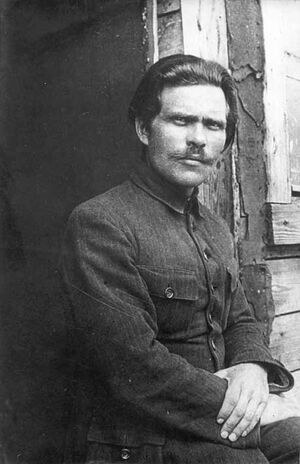Nestor Makhno
(revolutionary) | |
|---|---|
 | |
| Born | Nestor Ivanovych Makhno October 26, 1888 the Ukraine, Russian Empire |
| Died | July 6, 1934 (Age 45) Paris, France |
Cause of death | tuberculosis |
| Children | Yelena |
| Spouse | Agafya "Halyna" Andreyevna Kuzmenko |
Nestor Ivanovych Makhno, commonly known as Bat'ko Makhno was a Ukrainian anarchist revolutionary and the commander of an independent anarchist army in Ukraine from 1917–21.
Makhno was the commander of the Revolutionary Insurrectionary Army of Ukraine, commonly referred to as the Makhnovshchina (loosely translated as "Makhno movement"). The Makhnovshchina was a predominantly peasant phenomenon that grew into a mass social movement. It was initially centered around Makhno's hometown Huliaipole but over the course of the Russian Civil War came to exert a strong influence over large areas of southern Ukraine. Makhno and the movement's leadership were anarcho-communists and attempted to guide the movement along these ideological lines. Makhno was aggressively opposed to all factions that sought to impose their authority over southern Ukraine, battling in succession the forces of the Ukrainian National Republic, the Central Powers of Germany and Austro-Hungary, the Hetmanate state, the White Army, the Bolshevik Red Army, and other smaller forces led by various Ukrainian atamans.
He is also credited as the inventor of the tachanka—a horse-drawn carriage with a mounted heavy machine gun.[1] Makhno and his supporters attempted to reorganize social and economic life along anarchist lines, including the establishment of communes on former landed estates, the requisition and egalitarian redistribution of land to the peasants, and the organization of free elections to local soviets (councils) and regional congresses. However, the disruption of the civil war precluded a stable territorial base for any long-term social experiments.
Although Makhno considered the Bolsheviks a threat to the development of an anarchist Free Territory within Ukraine, he entered into formal military alliances twice with the Red Army to defeat the White Army. In the aftermath of the White Army's defeat in Crimea in November 1920, the Bolsheviks initiated a military campaign against Makhno. After an extended period of open resistance against the Red Army, Makhno fled across the Romanian border in August 1921. In exile, Makhno settled in Paris with his wife Halyna and daughter Yelena. During this period, Makhno wrote numerous memoirs and articles for radical newspapers.[2][3] Makhno died in 1934 in Paris at the age of 45 from tuberculosis-related causes.
References
- ↑ Michael Malet, Nestor Makhno in the Russian Civil War, Macmillan, 1982, 85. For the pioneering use of tachanki by Makhno and a statement to the effect that the Red Army "copied" the Makhnovist tachanki see, Leon Trotsky, How the Revolution Armed: The Military Writings and Speeches of Leon Trotsky, London: New Park Publications, 1981, 295 (note).
- ↑ Nestor Makhno, [1927] The Russian Revolution in Ukraine, Edmonton: Black Cat Press, 2007; [1936] Under the Blows of the Counterrevolution, Edmonton: Black Cat Press, 2009; [1937] The Ukrainian Revolution, Edmonton: Black Cat Press, 2011; The Struggle Against the State and Other Essays, Oakland: AK Press, 2001.
- ↑ Organizational Platform of the General Union of Anarchists (Draft), trans. Nestor McNab, 2006.